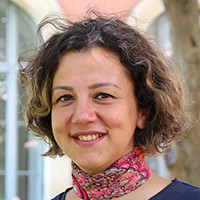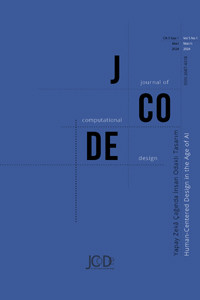Research Article
Dissertation
Issue Editorial Board


Aim & Scope
JCoDe Journal of Computational Design aims to contribute to scientific research, practice, and education by publishing national and international studies related to its subject and articles produced from graduate theses. The articles to be published in the journal should present new knowledge in the subject area or bring a new approach to the existing knowledge, emphasize the significance of the presented subject in the field, and reflect the results of a deep research.
JCoDe Journal of Computational Design is a peer-reviewed journal published twice a year with a summary in English and Turkish. The journal publishes academic and scientific articles and book reviews on computational design, planning, research, and education.
Author Guidelines
For research across all scientific disciplines that require ethical committee consent, the researchers must have obtained this approval, and it should be explicitly indicated and documented within the article. The relevant documentation should be attached. In studies that require ethical committee permission, details pertaining to the approval (i.e., committee name, date, and reference number) should be delineated in the methods section. Additionally, this information should appear on either the first or last pages of the manuscript. For case presentations, the article should also incorporate a statement confirming that informed voluntary consent forms have been duly signed by the participants.
At the conclusion of the article, declarations including the Researchers' Contribution Ratio, any Acknowledgments and Support, and Conflict of Interest should be presented."
Please click here for the template of the manuscript.
Name of the Book, Name of the Author, Publication Year, Publisher, City, Number of Pages, Price, Type of Volume, ISBN no.
You can access the JCODE Manuscript Template in Word format, the Copyright and Author Agreement, as well as the Cover Page Form via the link below:
https://jcode.itu.edu.tr/guidelines-for-authors/
Ethical Principles and Publication Policy
ABOUT PUBLICATION ETHICS
Journal of Computational Design users (editor, author, reviewer, section editor, reader) take into account the ethical rules and responsibilities in the guideline developed by COPE (Committee on Publication Ethics). Manuscripts submitted to the journal go through a double-blind peer review process after being reviewed by an editor and at least two referees. Submitted articles should not be published elsewhere (including papers presented at scientific meetings and published in full text) or pending for publication.
ETHICAL PRINCIPLES AND PUBLICATION POLICY
1- Manuscripts submitted to the journal should not have been published elsewhere or sent for publication. If the manuscripts are accepted for publication, the Faculty of Architecture has all the publishing rights; It cannot be published elsewhere without the permission of the Faculty of Architecture. In case of quotation from published articles, the source must be specified.
2- Manuscripts submitted to the journal should be prepared in accordance with scientific ethical rules. In this regard, the condition of compliance with the Higher Education Institutions, Scientific Research and Publication Ethics Directive (See https://www.yok.gov.tr/Sayfalar/Kurumsal/mevzuat/bilimsel-arastirma-ve-etik-yonetmeligi.aspx). In addition, based on the guiding principles of ITU Social and Human Sciences Human Experiments (SB-INAREK), Health and Engineering Sciences Human Experiments (SM-INAREK) and the Internationally recognized Publication Ethics Committee (COPE / Committee on Publication Ethics), but an understanding that is open to developments in the field of scientific ethics is adopted, without being limited to these principles.
3- Journal of Computational Design (JCoDe) does not pay royalties for articles.
4- There is no application and page fee for the Journal of Computational Design (JCoDe).
5- The manuscripts, which are evaluated for the first time by the Editorial Board and are found not to be edited in accordance with the journal of Computational Design (JCoDe) publication principles, are returned to the author to be corrected in line with the publication principles before being sent to the referee.
6- Manuscripts that are evaluated for the first time by the Editorial Board and that comply with the Journal of Computational Design (JCoDe) publication principles are sent to two referees. In line with the reports from the referees, it is decided to publish the article, to request correction from the author within the framework of the report or to reverse the article, and the author is informed of the situation as soon as possible. In the event that one of the referee reports is accepted and the other is rejected, a third referee may be appointed for the article or the editorial board and editor reserve the authority to make the final decision on this issue without requiring a new referee appointment.
7- The Editorial Board has the right to publish an article with a positive referee review in another issues of the journal, considering the density of articles to be published in the relevant issue.
8- The authors acknowledge that they have transferred all their rights to the Faculty of Architecture for the sharing and reproduction of their manuscripts accepted for publication in printed or digital media.
9- The authors are obliged to provide their titles, institutions they work in, contact addresses, telephone numbers and e-mail addresses. Authors must also submit their scientific researcher number (ORCID information) to be obtained via the address https://orcid.org/register.
10- Authors are responsible for complying with the spelling rules (word count, font type, paragraph spacing, listing references in the text and at the end of the text) during the preparation of the articles.
REVIEW PROCEDURE
All articles submitted for evaluation must comply with the content and journal template. This eligibility is evaluated by the editor and assigned to the field editors. If the article is unsuitable for the journal template, the authors are informed as soon as possible. Field editors evaluate the conformity of the article to the field and journal writing rules. The field editor evaluation period for each article is one week. After the corrections are completed, the article is sent to the referees. The evaluation period for referees is 15 days, and the referee evaluates and reports the article. Authors are informed about these evaluations and reports. The editorial board controls all processes. If the referees deem it necessary, they have the right to request more than one correction and to see them again after they have been corrected. After the author makes the necessary corrections, the field editors check the article and prepare it for publication. All publication rights of accepted articles belong to the Journal of Computational Design. Articles cannot be published elsewhere, copied, or used without reference. No fee is charged from the authors for article submission and publication in our journal.
REVISION STAGE
Minor revisions must be uploaded to the DergiPark system no later than 10 days after the referee returns. This period is 15 days for major revisions. Along with the revised manuscript, authors should also submit a revision note that contains the changes in the manuscript and responses to all the reviewers’ comments. The revision note should be submitted as a Word document in the Dergipark Platform.
SCREENING FOR PLAGIARISM
The author should upload a similarity report (via Turnitin or iThenticate) with the article. The similarity included here must be less than 20%. If the rate is more than 20%, the article is returned to the author and editing is requested. If the similarity rate is still high, the journal has the right to reject the article.
REFEREE RESPONSIBILITIES
The peer-review process assists the editor and editorial board in making the editor’s decisions.
A referee who knows he is not qualified to review the research or cannot complete the evaluation within the specified time should notify the editor and not be involved in the review process.
The referees should keep the information or ideas obtained in the evaluation confidential and not use the materials in the article in their research. There should not be any conflict of interest. They should evaluate articles regardless of ethnicity, gender, sexual orientation, religious belief, citizenship, or political philosophies. Evaluation of the work should be done objectively, and the opinions in this evaluation should be expressed with supporting documents.
Reviewers should determine whether citations in the article are cited in references. They must report any significant similarity or overlap with previously published articles.
EDITOR RESPONSIBILITIES
The editor evaluates articles regardless of ethnicity, gender, sexual orientation, religious belief, citizenship, or political philosophies and decides which articles will be published in the journal. The decision should be appropriate to the article’s accuracy, validity, and importance and the journal’s scope. Current legal requirements regarding libel, copyright infringement, and plagiarism must be considered.
Editors ensure that all information about the submitted manuscript is kept confidential until it is published. In the process, editors should not allow a conflict of interest or competition between authors, editors, and reviewers.
Materials in a submitted article cannot be used in the editor’s research without the author’s express written permission.
AUTHOR RESPONSIBILITIES
Authors should accurately describe the work done and objectively discuss its importance. An article should contain the necessary details and references to allow citation of the work.
Authors should ensure that their work is original, and if other work is used, it should be cited appropriately. All sources used in the study should be cited. Plagiarism constitutes any unethical publishing behavior and is unacceptable.
Persons who do not contribute intellectually to the content in the creation of the work should not be specified as the author. All studies submitted for publication should be disclosed if any, and their relationships may constitute a conflict of interest. Changing the author responsibilities of a work whose evaluation process has begun (such as adding an author, changing the order of authors, or removing an author) cannot be proposed.
Authors may be required to submit raw data in connection with an article for editorial review, and this data must be stored for a reasonable time after publication.
Authors must not have submitted the same work for publication or consideration in another journal, and submitting the same study to multiple journals simultaneously is considered unethical behavior.
Authorship should be limited to those who have contributed significantly to work. All contributors must be listed as co-authors, and the corresponding author ensures that all contributing authors are included in the list of authors.
All authors must include a statement describing financial or other financial conflicts of interest that could be interpreted to affect the conclusions or interpretation of their paper. All sources of financial support for the project should be disclosed.
In addition to the explanations above, the following notes for authors should be considered.
PUBLICATION FEES
Journal of Computational Design (JCoDe) does not charge for the articles.
COPYRIGHT & LICENCING
The papers published in JCoDe are licensed under a Creative Commons Attribution-NonCommercial 4.0 International License. Except for commercial purposes, the resources herein can be reused, distributed, copied and edited.
OPEN ACCESS POLICY
The responsible publication owner of the JCoDe Journal of Computational Design is the Istanbul Technical University Rectorate in accordance with the provisions of the Press Law No. 5187.
JCoDe Journal of Computational Design is an open access electronic journal. You can read, download and print full text of articles. There is not publication and submission charge. Articles appeared in the journal cannot be used, as whole article or in part, without proper referencing.
Price Policy
The journal does not charge fees for publishing an article




